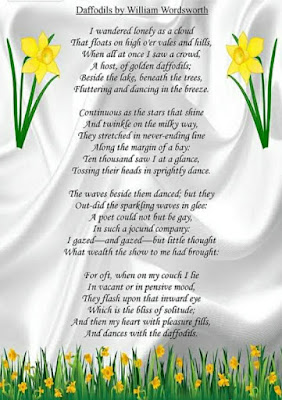The Deffodils by William Wordsworth
The Deffodils by William Wordsworth
Introduction :
William Wordsworth, (born April 7, 1770, Cockermouth, Cumberland, England—died April 23, 1850, Rydal Mount, Westmorland), English poet whose Lyrical Ballads (1798), written with Samuel Taylor Coleridge, helped launch the English Romantic movement.
The three or four years that followed his return to England were the darkest of Wordsworth’s life. Unprepared for any profession, rootless, virtually penniless, bitterly hostile to his own country’s opposition to the French, he lived in London in the company of radicals like William Godwin and learned to feel a profound sympathy for the abandoned mothers, beggars, children, vagrants, and victims of England’s wars who began to march through the sombre poems he began writing at this time.
NOTABLE WORKS
“The Solitary Reaper”
“The Prelude”
“Lyrical Ballads”
“The World Is Too Much with Us”
“Ode: Intimations of Immortality”
“Peter Bell”
“The Ruined Cottage”
“The Excursion”
“The Recluse”
“Michael”
Introduction :
The poem is not a result of the poet’s imagination. It is a product of his actual visualization. The poet expresses his feelings of solitude by saying ‘ I wandered as a lonely cloud’. The reason behind his feeling of loneliness was the death of a beloved one, his brother. Passing through a field beside the lake, he comes across a cluster of golden daffodils waving in the breeze. Moreover, they were more isolated patch or scattered. They were thousands and thousands in number dancing in the breeze.
Furthermore, the dancing, blinking flowers stretched endlessly along the shore. Also, the shining waves of the lake danced beside the flowers. The daffodils traced the water with their beauty. Moreover, the poet says, the golden daffodils twinkled and stretched in an endless line like the stars in the Milky galaxy way. It implies that the flowers seem heavenly as stars. This made the poet very happy as he has never seen so many daffodils at one sight. He enjoyed the company of flowers.
Furthermore, he keeps on starting that beautiful scene. He couldn’t take off his eyes from the loveliness of daffodils. However, he was unaware of the blessing that the scene would give him. From that time, whenever he felt lonely or depressed, the scene of the beautiful daffodils strike his strikes. Thus, his heart gets filled with immense pleasure and dances with the daffodils.
The plot is very simple. It depicts the poet’s wandering and his spotting of a field of daffodils by a lake Also, the memory of the daffodils pleasures him and relieves him when he is alone, bored, or suffering from feelings of restlessness. Moreover, the characterization of the surprising happening of a memory—the daffodils “flash upon the inward eye”, which is “the bliss of solitude”—is psychologically acute, but the poem’s major brilliance lies in the reverse personification of its initial stanzas.





Comments
Post a Comment